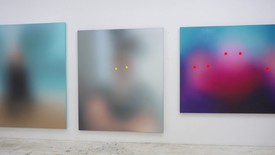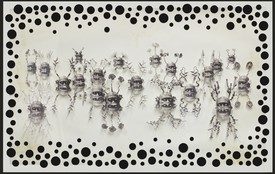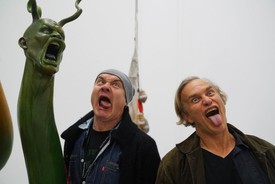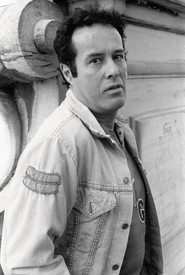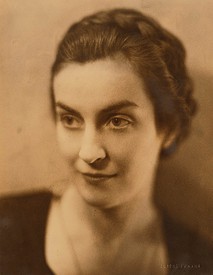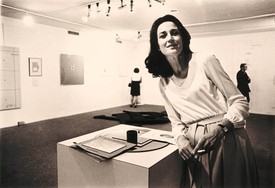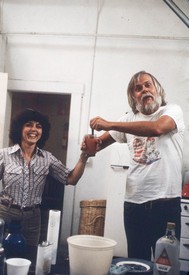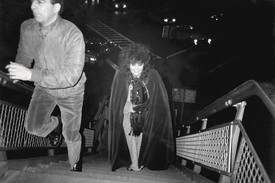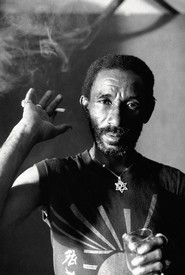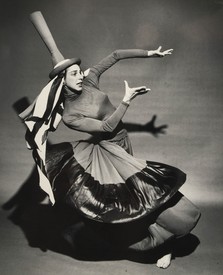
Michael Slenske is a Los Angeles–based writer and independent curator who has organized exhibitions at Praz-Delavallade, the Landing, Wilding Cran Gallery, and Frieze LA. His work has been anthologized, included in many artists’ monographs, and appears regularly in W, Galerie, and Los Angeles Magazine. Photo: Ry Rocklen
“There’s nothing out there, Ash!” This was the “incessant mantra” Ashley Bickerton recalled Jack Goldstein whispering to him day in and day out during the four years he worked as Goldstein’s lead fabricator in the early ’80s. The “cult of two” would paint and pontificate at a fever pitch in Goldstein’s Brooklyn studios—Jack manically sweeping the floors and priming the canvases like an assistant, Ashley imbuing Goldstein’s pictures with a dark magic from his adroit hand, like some shamanic genius—as the duo waged a quiet war against the dangers of an “ever-looming art world populated by lightweights, vulgarians and false prophets that would lead the true cultural heart of America down any number of doomed aesthetic cul-de-sacs.” At least that is how Ashley remembered his first prime-time gig, fresh out of the California Institute of the Arts, in an essay (“Jack ’n Me”) that he penned in the fall of 2012 at his home in Bali. The piece was written at a fulcrum point, nearly a decade after Goldstein took his own life at his San Bernardino home and nearly a decade before Ashley passed away beside his wife, Cherry, and daughter, Io, at his oceanside retreat in Indonesia this past November due to complications from Lou Gehrig’s disease.
Of course there was something out there, Ash! Something big. The pulsing heart of American capitalism in all its Reaganite excess, a consumerist cornucopia, just waiting to be opened up and examined under the surgical lights of your surf-stoked operating theater. For the better part of four decades, this Barbados-born Englishman—conceived in the cabin of a passenger boat in the mid-Atlantic during a thunderstorm, according to his father—poked and prodded at every facet of his adopted homeland’s capitalist bonanza, where, he mused, if “every inspirational and unconflicted surface, from an athlete’s shirt to the summer sky above your beach, could be ‘utilised’ by advertising, why not art?”
Why not indeed. Ashley weaponized his Susie boxes, Culture-scapes, and Logo paintings to invert the meaning, materiality, and function of paintings, reducing them to a glut of “dehydrated culture units” that utilized the language of advertising and product placement that he’d seen cropping up on one of his most sacrosanct tools: the surfboard, especially those of pro riders. The son of an itinerant creole and pidgin linguist, whose research took the family from Ghana to Guyana to Honolulu, the acquisitive Ashley was primed to deconstruct and recode the formal languages of the art world.
“Attempting a summing up of Bickerton’s vast and subversive body of work is pointlessly reductive,” Paul Theroux astutely observed in a 2017 profile for the Guardian, although there are more than a few mile markers worth stopping at. His text-based Susie paintings, the first works he made after landing in New York in 1982, established his branded alter ego, Susie Culturelux, with a typeface that seemed to mimic that of the Starwood nightclub in West Hollywood. He wanted to “drive that wedge deeper” between the word and its form with his Non-Word Word paintings featuring phonetic grunts—Kuk, Gog, Guh, and Ugh—on gold, silver, and bronze-painted Susie boxes. By the mid-’80s, Ashley was at the vanguard of the Neo-Geo (or Neo-Geometric Conceptualism) movement—so-called in the wake of a 1986 group show featuring the work of Ashley, Jeff Koons, Peter Halley, and Meyer Vaisman at Sonnabend Gallery. It was a name Ashley hated, preferring the moniker of “commodity art” or “neo-conceptualism” to define his angle of attack. This position comes into crystal focus in Tormented Self-Portrait (Susie at Arles) (1987–88), which predicted the age of the influencer like nothing else. Inspired by “an eternity of self-portraits” he’d seen in a Vincent van Gogh retrospective at the Metropolitan Museum of Art in 1986, Ashley defined bickerton, the artist, not by a series of Neo-Expressionist brushstrokes but rather by a matrix of screen-printed logos from Body Glove, CalArts, Marlboro Lights, the Village Voice, Gusano Rojo Mezcal, and Trojan condoms decorating a Donald Judd–like painting plane made of wood, anodized aluminum, rubber, plastic, Formica, leather, chrome-plated steel, and canvas. It was arch, and biting, but also humorous, even fun.
“Maybe somewhere in this circumscribed liberty of obvious, eccentric, contradictory and choiceless choices we can pinpoint an individual,” Ashley once explained, noting that he could be a macrobiotic Marlboro Man who wore “American yokel” underwear while driving a Renault and relaxing on Bauhaus furniture. To assume anything else was “curatorial laziness, it’s editorial laziness,” he once told me. “Artists are dynamic and functioning in many ways and shapes over time but you’re often given a window of being fashionable and that’s marked and indexed into the dialogue of this so-called history.”
A few years after the self-portrait, Ashley found eight clients—including Sonnabend Gallery, the art dealer Leo Castelli, the designer Nina Ricci, and his Neo-Geo cohort Jeff Koons—to put their names on a subsequent Logo work, though he never motivated himself to collect on his advertising fees. “All I ever really needed was their commitment to make the piece legit,” he reasoned. “Then again, maybe a $1,000 shopping spree at Nina Ricci would have been worth getting off my ass.”
The thing about Ashley was that he always got off his ass, even after he was bound to a wheelchair these past two years. “I don’t want any pity. I’m not really in the mood for that shit,” he told me in the summer of 2021 for an article that was meant to follow his triumphant return to Los Angeles, where he reclaimed his spot as a California surfer until his ALS rendered his cliffside Mount Washington home unusable. Still, he was resolute. “Life is to be lived and got on with, and I’m busy—too busy—for that.”
Ashley was so busy, in fact, that he worked from his room in the ICU on his final body of work, the Blur paintings, haunting color fields from which shadowy figures emerge with glowing-yellow headlight eyes. They consumed the last eight months of his life, and will form the basis of his solo debut at Gagosian this fall.
After his ALS diagnosis, Ashley was worried about the “bifurcated understanding” of his oeuvre, which in its most simplified form could be understood as BB and AB (Before Bali and After Bali). Before he moved to Bali, in 1993, he was already transitioning away from outwardly commodity-obsessed work to “landscapes” that commodified and sublimated natural elements into fetishistic wall-mountable sculptures. Some encapsulated cowboy getups, others taxonomical seed specimens, in seaworthy vessels strapped to pontoons, which he’d later fill with Indian Ocean flotsam or, poetically, his family’s footprints last year. His Early Bali Paintings, depicting the cartoonish cultural masks of art-world insiders, and his Gauguin-on-acid Blue Man paintings of a twentieth-century antihero outsider blissed out in paradisiacal excess, inspired countless younger artists, including Jamian Juliano-Villani, who organized a beloved show—Ashley’s last New York hurrah IRL—at her buzzy downtown gallery, O’Flaherty’s, during the pandemic. But it was Ashley’s most recent series, Ocean Chunks, that may have been the closest to his heart at the end.
“People judge through the filter of their own projection and they judged my last show of Ocean Chunks through the filter of my disease. Somehow I was dealing with death, removal, silence. Fine with me. I was. But if they thought that last show was about death, what the hell are they gonna think about these paintings?,” Ashley told friend and filmmaker Thomas Nordanstad just before his passing, for a forthcoming documentary about the artist. “Guess what? It doesn’t matter. It’s fine to see them through that filter. My work has always been able to hold more than one contradictory viewpoint at once. That’s the whole purpose of my work.”
His last marks, which he was working on until the very last moments of his life, began with the discovery of some faded photographs in a wallet. From casual snapshots of his friends and family, the Blur paintings capture everything from Io’s passport photo to Cherry and Ashley on their wedding day, and reverse engineer—or perhaps project forward—his own disappearance, the world blurring from his vision, his body ebbing out to sea.
Seen from that vantage, the Blur paintings provide a poetic coda to the Ocean Chunks, which Ashley thought of “as a facsimile, a cutout, of the way a Catholic will think about a crucifix above their bed . . . for whatever the hell it is that I believe in, which basically, I guess, is just waters of world in the larger gaia and, more specifically, the warm embalming fluid of tropical water as we return to the amniotic sac.”
Sometimes I imagine him out there in the ether, getting tubed by that perfect turquoise wave, like the one he was famously photographed riding (sans logos) at Padang Padang. If I could ask him one last question, I’d simply want to know: “What’s out there, Ash? What’s out there beyond the blur?”


